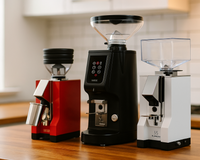From Dairy to Oat: The Ultimate Guide to Choosing the Best Milk for Your Latte or Cappuccino
Milk is an essential component in many coffee drinks, and choosing the right type of milk can make all the difference in taste and texture. Whether you prefer a classic latte or a frothy cappuccino, the milk you choose can enhance or detract from the overall coffee experience. But with so many different types of milk available, it can be overwhelming to decide which one to use.
In this ultimate guide, we'll explore the best types of milk for lattes and cappuccinos, as well as the best milks for drinking straight. We'll also discuss which types of milk to avoid, and why. Whether you prefer dairy or non-dairy options, we've got you covered. So sit back, grab your favorite mug, and let's dive into the wonderful world of milk in coffee!
Milks we'll cover in this post:
-
Whole Milk: Whole milk is a popular choice for lattes and cappuccinos because of its high fat content, which creates a creamy texture when steamed. Whole milk has a mild flavor that won't overpower the taste of the coffee.
-
2% Milk: 2% milk is a good alternative to whole milk, with a lower fat content but still enough fat to create a creamy texture when steamed. It also has a slightly sweeter taste than whole milk, which can complement the flavor of the coffee.
-
Oat Milk: Oat milk is a great dairy-free option for lattes and cappuccinos. It has a creamy texture and slightly sweet flavor that pairs well with coffee. Oat milk also froths well, making it a good choice for latte art.
-
Soy Milk: Soy milk is another dairy-free alternative that works well in lattes and cappuccinos. It has a mild, slightly nutty flavor that won't overpower the taste of the coffee. Soy milk also froths well, although it can be a bit trickier to work with than cow's milk.
-
Almond Milk: Almond milk is another popular dairy-free option that can be enjoyed on its own or in coffee drinks. It has a slightly nutty flavor and a thinner texture than cow's milk, but still has a creamy mouthfeel.
In addition to these milks, we'll also discuss which types of milk to avoid when making coffee drinks, such as skim milk and flavored milk. By the end of the post, readers should have a clear understanding of which types of milk work best for their preferred coffee drinks, as well as some new options to try.
Unlock the Ultimate Coffee Experience: Join Blue Bottle's Exclusive Subscription Club!
Best Milks for Lattes and Cappuccinos
When it comes to making the perfect latte or cappuccino, the type of milk you choose can make all the difference in achieving that velvety texture and smooth taste. While there are many types of milk to choose from, not all are created equal. In this section, we'll explore the best milks for lattes and cappuccinos, including whole milk, 2% milk, oat milk, and soy milk. We'll explain why each type of milk works well in coffee drinks, and how to choose the right one for your preferences. So if you're ready to up your coffee game, read on to discover the best milks for your lattes and cappuccinos.

[Preferred] Whole Milk
Whole milk is a popular choice for lattes and cappuccinos because of its high fat content. The fat in whole milk helps to create a creamy, velvety texture when the milk is steamed, which is essential for achieving that classic, frothy texture in lattes and cappuccinos.
In addition to its texture benefits, whole milk has a mild flavor that won't overpower the taste of the coffee. This allows the flavor of the coffee to shine through, while still providing a smooth, creamy mouthfeel.
While whole milk is higher in fat than other types of milk, it can still be part of a healthy diet when consumed in moderation. It contains important nutrients such as calcium, vitamin D, and protein, which are all beneficial for bone health and overall nutrition.
Overall, if you're looking to make a classic latte or cappuccino with a smooth, creamy texture, whole milk is a great choice.
[Preferred] 2% Milk
2% milk is a good alternative to whole milk for lattes and cappuccinos. While it has a lower fat content than whole milk, it still contains enough fat to create a creamy texture when steamed.
In addition to its texture benefits, 2% milk has a slightly sweeter taste than whole milk, which can complement the flavor of the coffee. This can be especially beneficial for people who find whole milk to be too rich or heavy.
Like whole milk, 2% milk is a good source of calcium, vitamin D, and protein, which are all important nutrients for overall health.
[Preferred] Oak Milk
Oat milk is a popular dairy-free alternative that works well in lattes and cappuccinos. It has a creamy texture and slightly sweet flavor that pairs well with coffee. Oat milk is made by blending oats and water, which results in a smooth, velvety texture that froths well when steamed.
One of the benefits of oat milk is that it's naturally sweet, which means you may not need to add additional sweetener to your coffee. Oat milk is also a good source of fiber and other important nutrients, such as vitamin D and calcium.
Because oat milk is plant-based, it's a great option for people who are lactose intolerant or have other dietary restrictions. Additionally, oat milk is more sustainable than dairy milk, as it requires less water and produces fewer greenhouse gas emissions.
[Preferred] Soy Milk
Soy milk is another popular dairy-free alternative that works well in lattes and cappuccinos. It has a mild, slightly nutty flavor that won't overpower the taste of the coffee. Soy milk is made from whole soybeans and water, and has a similar consistency to dairy milk.
One of the benefits of soy milk is that it froths well when steamed, making it a great option for latte art. Soy milk is also a good source of protein and other important nutrients, such as calcium and vitamin D.
Because soy milk is plant-based, it's a great option for people who are lactose intolerant or have other dietary restrictions. However, it's important to note that soy is a common allergen, so it may not be suitable for everyone.
Milks to Avoid
When steaming milk for a latte or cappuccino, it is best to avoid using ultra-high temperature (UHT) milk, as it can produce an unpleasant taste and texture. UHT milk has been heated to a very high temperature to extend its shelf life, which can affect its ability to froth properly.
It is also important to avoid using skim milk or low-fat milk, as these types of milk do not have enough fat content to produce a good froth. Whole milk or 2% milk are better options for steaming and frothing, as they contain enough fat to produce a creamy and smooth texture.
If you are looking for non-dairy alternatives, it is best to use soy milk, almond milk, or oat milk. These types of milk can also be steamed and frothed, but may have a slightly different taste and texture compared to dairy milk.

[Avoid] Ultra-high temperature (UHT) milk
UHT milk has been heated to a very high temperature to extend its shelf life. This high-temperature heating process can change the milk's proteins and sugars, causing it to have a different taste and texture than regular milk. Some people describe UHT milk as having a "cooked" or "burnt" taste, which can negatively affect the flavor of the coffee drink. Additionally, the altered proteins and sugars in UHT milk can make it difficult to achieve a good froth, resulting in a lackluster latte or cappuccino. Therefore, it is generally recommended to use fresh, regular milk when steaming for a latte or cappuccino to ensure the best taste and texture.
[Avoid] Skim milk or low-fat milk
These types of milk have lower fat content, which makes it difficult to achieve a rich, creamy froth. The fat in milk helps stabilize the air bubbles created during the steaming process, creating a smooth and velvety texture in the frothed milk. Skim milk or low-fat milk contains less fat than whole milk or 2% milk, which means that there is less fat available to help create the desired froth. As a result, the froth from skim milk or low-fat milk tends to be thin and lacking in body, which can negatively affect the taste and texture of the coffee drink.
[Avoid] Non-dairy creamers or flavored creamers
Non-dairy creamers or flavored creamers are best avoided when steaming for a latte or cappuccino because they are not designed for use in espresso-based drinks. Non-dairy creamers are typically made with a combination of water, vegetable oil, and other additives, such as artificial flavors and sweeteners, to mimic the taste and texture of dairy cream. Flavored creamers may also contain additional ingredients, such as syrups or extracts, to impart a particular flavor to the milk.
These types of creamers may not froth properly when steamed, due to their lack of natural proteins and sugars, which can affect the taste and texture of the latte or cappuccino. Additionally, the artificial flavors and sweeteners in non-dairy creamers and flavored creamers may not blend well with the coffee, resulting in an unbalanced flavor.
[Avoid] Sweetened condensed milk
Sweetened condensed milk is best avoided when steaming for a latte or cappuccino because it is a highly concentrated and sweetened form of milk. It contains a lot of sugar, which can make it difficult to achieve a good froth, as the sugar can interfere with the proteins in the milk that are responsible for creating the froth. Additionally, sweetened condensed milk has a very thick and syrupy consistency, which can be difficult to steam and may result in an overly sweet and cloying latte or cappuccino.
[Avoid] Flavored milk (e.g. chocolate milk)
Flavored milk, such as chocolate milk or strawberry milk, is best avoided when steaming for a latte or cappuccino because it contains added sugar and flavorings that can interfere with the taste and texture of the coffee drink. The added sugar can make it difficult to achieve a good froth, as the sugar can interfere with the proteins in the milk that are responsible for creating the froth. Additionally, the added flavorings can overpower the taste of the coffee, resulting in an unbalanced flavor. Flavored milk also tends to be thicker and heavier than regular milk, which can make it more difficult to steam and froth properly.
[Avoid] Milk with added thickeners (e.g. carrageenan)
Milk with added thickeners, such as carrageenan, is best avoided when steaming for a latte or cappuccino because the thickeners can interfere with the texture of the milk when it is heated and frothed. Carrageenan is a common thickener used in dairy products, such as milk and cream, to improve their texture and stability. However, when heated, carrageenan can cause the milk to become too thick and heavy, making it difficult to achieve a good froth. Additionally, carrageenan can impart a slimy or gelatinous texture to the milk, which can negatively affect the taste and texture of the coffee drink.
[Avoid] Milk substitutes that are low in protein (e.g. rice milk)
Milk substitutes that are low in protein, such as rice milk, are best avoided when steaming for a latte or cappuccino because they lack the natural proteins and sugars that are necessary for creating a good froth. Proteins and sugars are responsible for stabilizing the air bubbles that are created during the steaming process, which helps to create a smooth and velvety texture in the frothed milk. Milk substitutes that are low in protein, such as rice milk or coconut milk, do not contain enough of these key components to create a good froth. As a result, the froth from these types of milk substitutes tends to be thin and lacking in body, which can negatively affect the taste and texture of the coffee drink.
In Conclusion
In conclusion, the choice of milk plays an important role in creating the perfect latte or cappuccino. To achieve a rich and creamy froth, it is best to use whole milk or 2% milk, as they contain enough fat to create a smooth and velvety texture. Non-dairy milk alternatives, such as soy milk or almond milk, are also great options, as they can be steamed and frothed to create a similar texture and taste to dairy milk. However, it is important to avoid certain types of milk, such as UHT milk, skim milk, flavored milk, sweetened condensed milk, and milk with added thickeners, as they can negatively affect the taste and texture of the coffee drink. By selecting the right type of milk, coffee lovers can enjoy a perfectly steamed and frothed latte or cappuccino every time.















